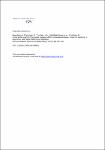Is low birth weight in the causal pathway of the association between maternal smoking in pregnancy and higher BMI in the offspring?
Beyerlein, Andreas
Rückinger, Simon
Toschke, André Michael
Rosario, Angelika Schaffrath
Kries, Rüdiger von
A number of cross-sectional and prospective studies suggested a priming effect of maternal smoking in pregnancy on offspring’s obesity. It has been hypothesized that this association might be explained by low birth weight and subsequent catch-up growth in the causal pathway. We therefore examined the role of birth weight in children exposed versus not exposed to cigarette smoking in utero on later body mass index (BMI). Using data of 12,383 children and adolescents (3–17 years of age) recorded in a German population-based survey (KiGGS), we assessed mean body mass index standard deviation scores (BMI-SDS) in different birth weight SDS categories, stratified for children with smoking and non-smoking mothers. We calculated spline regression models with BMI-SDS as outcome variable, cubic splines of birth weight SDS, and potential confounding factors. Children whose mothers had been smoking during pregnancy had lower birth weight SDS and higher BMI-SDS at interview compared to children of non-smoking mothers. However, we observed a linear association between birth weight SDS and BMI-SDS in crude analyses for both groups. Similarly, almost linear effects were observed in adjusted spline regression analyses, except for children with very low birth weight. The respective 95% confidence bands did not preclude a linear effect for the whole birth weight SDS distribution. Our findings suggest that low birth weight is unlikely to be the main cause for the association between intrauterine nicotine exposure and higher BMI in later life. Alternative mechanisms, such as alterations in the noradrenergic system or increased food efficiency, have to be considered.
Dateien zu dieser Publikation
Keine Lizenzangabe

